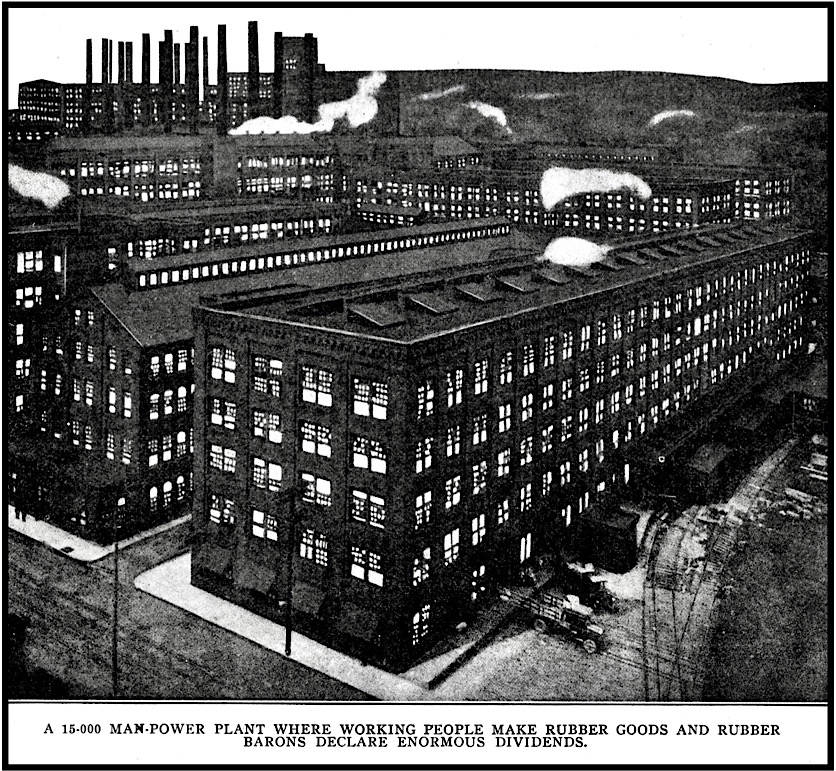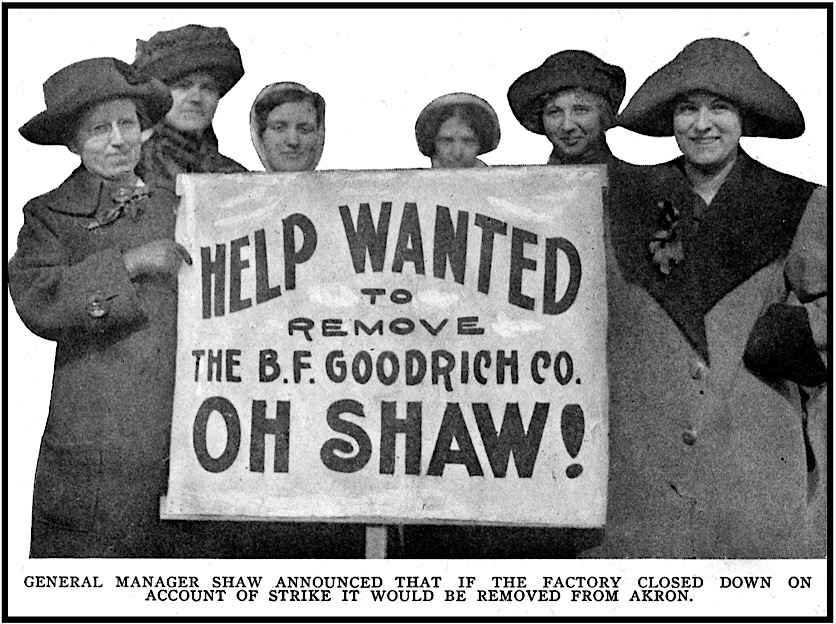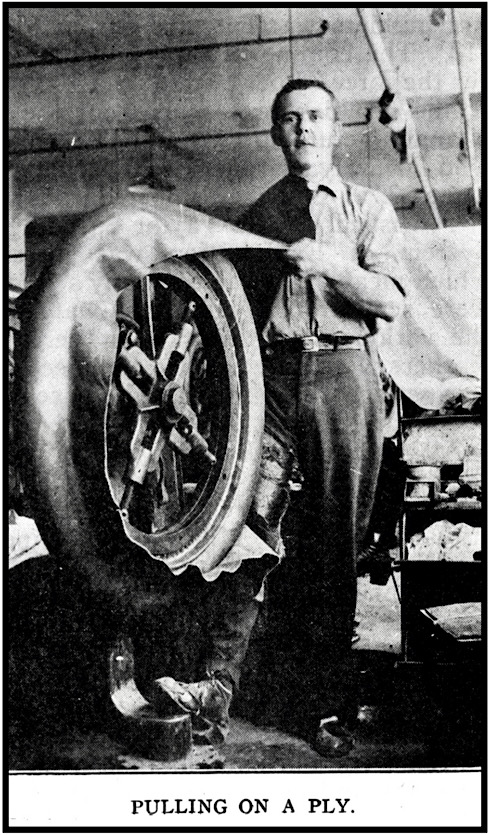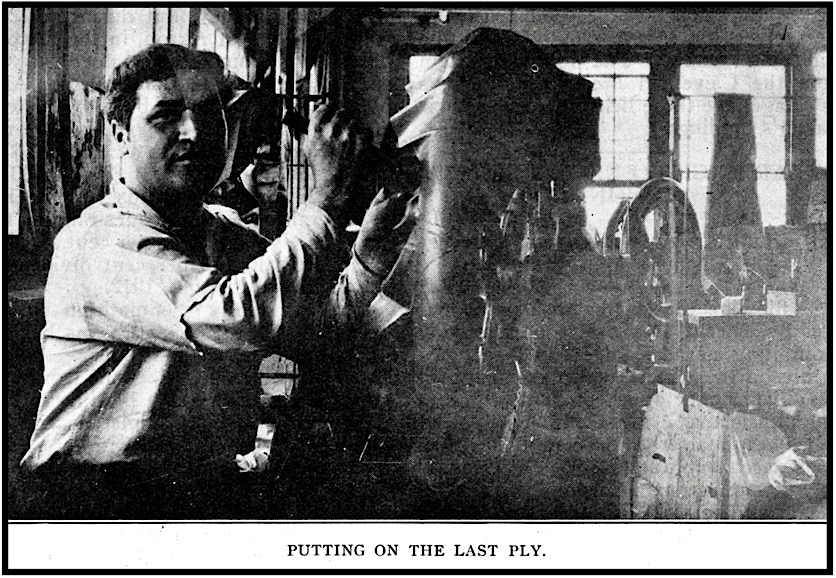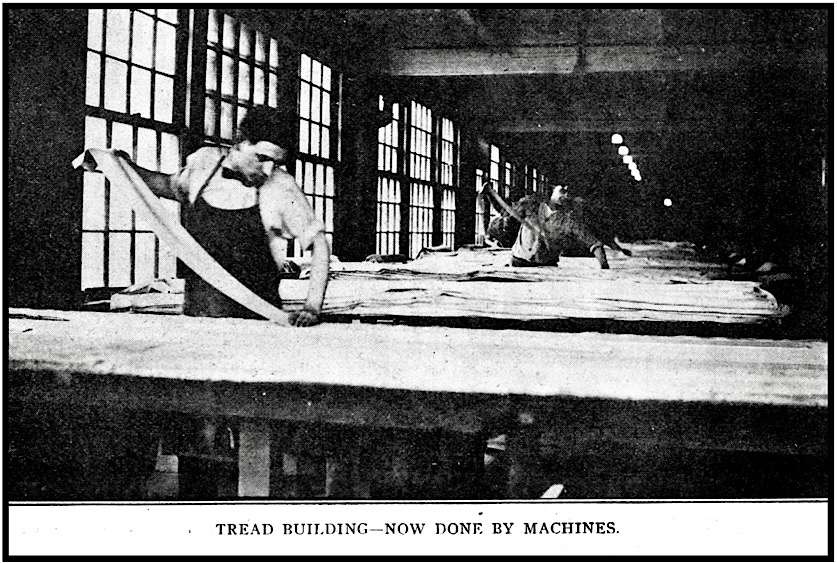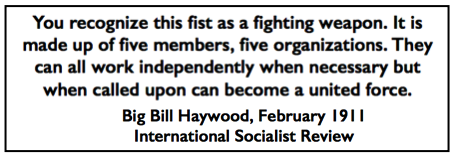 —————
—————
Hellraisers Journal – Wednesday April 16, 1913
Akron, Ohio – 20,000 Workers on Strike Against Rubber Barons
From the International Socialist Review of April 1913:
800 Per Cent and the Akron Strike
By Leslie H. Marcy
[Part I of IV]
THE Rubber Aristocrats are having “tire trouble” in Akron, Ohio. Their mammoth 75-acre, 25,000-man-power, profit-making machines-known as the Goodrich-Diamond, Goodyear, Firestone and Buckeye rubber factories, have been badly punctured by a strike of 20,000 wage slaves.
The workers who have slaved for years laid down the bosses’ tools, rolled up their greasy working rags and walked out unorganized, on February 10, as a protest against tyrannical working conditions and repeated cuts in wages.
They are standing shoulder to shoulder and their arms are folded. There is no fire under the boilers; nor smoke issuing from the hundreds of industrial spires; the belts are on loose pulleys and even the wheels refuse to run.
The Rubber Barons refused to arbitrate with the state officials and threatened to move their plants from the city. Meanwhile the strike was rapidly being organized by militant members of the Socialist party working with the Industrial Workers of the World. The Socialist headquarters became the home of the strike committees while larger halls were secured for mass meetings, where thousands of workers hear the message of Revolutionary Socialism and Industrial Unionism. Comrades Frank Midney, “Red” Bessemer, George Spangler and fellow-workers George Speed, William Trautman, Jack Whyte and several more “live ones” are on the job speaking daily, organizing committees and strengthening the picket lines.
The home of Comrade Frank and Margaret Prevey was thrown open to the strikers and became a busy center of strike activity-sending out appeals for support, press notices and planing the work of taking care of those who were in need. Here was a hive that hummed twenty hours out of the twenty-four. Of course the Capitalist hirelings suddenly discovered that this was “an Agitators’ meeting place,” and made dire threats.
But the Rubber Barons in their palaces out on West Hill were also busy moulding public opinion through press and pulpit against this “foreign devil” called a strike. Were not collections dwindling on Sundays and business becoming “bad” during the week, and is not idleness the devil’s workshop?
Thereupon a great cry arose from the Citizens’ Welfare League and the Akron Times, warning the honest, respectable, patriotic law-abiding American citizens against the strike as “an attack on the prosperity of our city,” and announcing that “the powers that be are ordained of God.” This league was organized by Rev. Atwater and the Rubber Heads have donated him an automobile for his services in organizing slugging crews.
As city, county and state governments are but committees to do the bosses’ bidding, so likewise the pulpit, press and bar are proving themselves ready to prostitute themselves for a few crumbs from the rich man’s table. The following item from the Cleveland Plain Dealer shows how eager are these lickspitles to do their master’s bidding:
———-
SWEAR IN CITIZENS TO PROTECT AKRON.
———-
Police Officials Arm Ministers, Lawyers
and Business Men of City.
———-Following the issuing of a proclamation by Sheriff David Fergusson today prohibiting parades and crowds congregating on the streets, 700 prominent Akron citizens, including merchants, lawyers and physicians, presented themselves at police headquarters and asked to be sworn in as special policemen.
All were accommodated and with police badges and heavy police night sticks were assigned to duty this afternoon. Among the men made special police were: M. O’Neil, proprietor of the May Co. department store; Francis Seiberling, J. H. Adams and W. E. Smoyer, lawyers; Rev. George P. Atwater; W. C. Hall, insurance agent; W. B. Baldwin, postmaster; Dr. D. H. Morgan; George Bates, banker; George W. Cornuchael, contractor.
For hours they were sworn in as fast as Mayor Rockwell could repeat the oath. Clubs and ax-handles were distributed among them and each man was given a yellow ribbon, designating his authority.
The entire Young Men’s Christian Association was sworn in as deputies.
Tuesday evening March 13th, a squad of these thugs clubbed a group of girl strikers, as they were going up the stairs into the Socialist headquarters. On Friday, March 14th, Comrade Haywood was met at the depot by the Citizens’ Committee and the chief of police started to recite his little piece about no revolutionary speeches, etc., etc. But Comrade Haywood rudely interrupted with the query: “Have you a warrant to serve?” Upon the chief’s replying that he had none Comrade Haywood said, “Please step aside,” and passed through the crowd to the waiting strikers, who cheered him lustily. Thus the class lines have been drawn and the struggle is on in Akron.
Fifteen years ago the rubber industry was in its infancy, but during 1912 the wage workers of Akron, in the factories, produced commodities valued at $99,462,944 and the valuation placed on Akron plants, which were also built by the workers was placed at $46,966,509. One company which started with a capital of $100,000 is now capitalized at $10,000,000 and during last year dividends were declared by several rubber companies ranging from seven to eight hundred per cent. And one company paid 100 per cent dividend for the month of August, 1912.
But gradually competition became keener and the Rubber Barons began to install labor-saving machinery. A stock-cutting machine now does the work of ten men. Four years ago a beading machine was invented which completely wiped out hundreds of hand bead workers. Four men operating a machine could produce as much as a whole corps of trained hand workers. Before the advent of the tire building machine a hand tire builder turned out ten three-inch tires in ten hours, receiving 35 cents per tire on piece work. Now the tire building machine produces 112 three-inch tires all trimmed and ready for the finishers in ten hours. In the Diamond factory alone the force of tire builders was cut down from 510 to 112. The coming of these machines has cut the force 75 per cent.
The machine process has cut the cost of manufacture in two and tire builders who formerly averaged $4.20 per day now make $2.70. But the Rubber Barons were not satisfied, so the Taylor Speeding-Up System of Exploitation was installed, which means that the company’s “stools” were sent around with stop-watches in the various departments and the fastest workers were timed. Then the piece scale was set according to what the pacemaker could turn out.
As the Rubber Barons grew in wealth they became more arrogant to their employees. Fines were levied for the most trivial mistakes. Mike Flynn, superintendent of the fire department of the Diamond plant “fired” fifty men because someone threw a small piece of rubber out of a window. Such is the way the free American rubber workers have been treated in Akron for years, and they have at last revolted.
Under the old hand-method of making tires, the cutting of “stock” or fabric was all done by hand. The tread-builders also worked by hand, rolling and pressing the duck fabric for the tire builders. In the builders’ room, an iron core, weighing from 100 to 500 lbs., the exact size of the cavity, was covered with glue, or cement, and a light fabric pulled over it. The core then went to the tire builders.
Starting the fabric which was held by “sewing-in” with a rotary wheel, the builder stitches his stock 1½ inches to every foot. Stock is sometimes cut so close that the operator has often to release and restretch the fabric many times before the ends meet.
—–
One of these photographs shows the builder putting on the third ply with edges trimmed. The last ply is carefully worked over the beads and “sewed in” ready for the gumming pits.
After the final cut the tire is sent to a calendar room to receive a coat of composition.
[Emphasis added.]
~~~~~~~~~~~~~~~~~~~~~~~~~
SOURCES & IMAGES
Quote BBH One Fist, ISR p458, Feb 1911
https://play.google.com/books/reader?id=8-05AQAAMAAJ&printsec=frontcover&pg=GBS.PA458
International Socialist Review
(Chicago, Illinois)
-Apr 1913, pages 711-714
https://www.marxists.org/history/usa/pubs/isr/v13n10-apr-1913-ISR-riaz-ocr.pdf
See also:
American Rubber Workers & Organized Labor, 1900-1941
-by Daniel Nelson
Princeton University Press, Jul 14, 2014
(search: with last names mentioned above)
https://books.google.com/books?id=LAMABAAAQBAJ
James P. Cannon and the Origins of the American Revolutionary Left, 1890-1928
-by Bryan D. Palmer
University of Illinois Press, Oct 1, 2010
(search: with names mentioned above)
https://books.google.com/books?id=3m_97zuy6_MC
Tag: Akron Rubber Workers Strike of 1913
https://weneverforget.org/tag/akron-rubber-workers-strike-of-1913/
~~~~~~~~~~~~~~~~~~~~~~~~~
What We Want – John McCutcheon
Lyrics by Joe Hill

